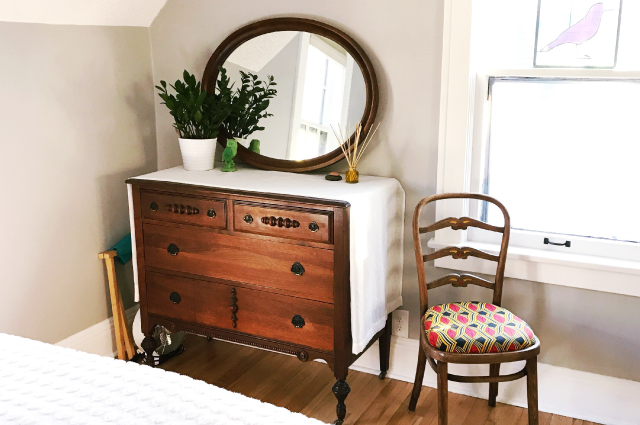Tips for Minimalist Living.
Minimalist living is much more of a mindset than narrowly defined set of ‘rules”.
You don’t have to paint your walls white and own a 100 items or less to consider yourself a minimalist. While you probably will end up owning less stuff, the goal of the minimalist movement is to remove the items in your home (and life!) that distract you from living aligned to your personal values.
Ultimately, it will become easier to let go of the stuff you no longer need, so you can focus more on experience-based living, which research has shown leads to a happier and healthier life.
Minimalist Living Tips.
Identify your priorities.
It’s easy to say what our priorities are, it’s another to actually live them. Be honest with yourself as you answer the following questions:
How am I currently spending my time, money, and energy?
How would I like to spend my time?
What does my ideal day, weekend, or evening look like?
What hobbies or interests would I like to spend more time pursuing?
What am I willing to let go of to make space for that those people or activities?
2. Identify Your Blocks.
If you’re having trouble figuring out how to make space for the people or activities you love, ask yourself if the road block is real or imagined. If you feel like you have zero time to declutter you home, but it’s stressing you out on a regular basis, then finding ways to reduce stress in your life should probably be a priority. You could ask a friend to come watch your kids for an afternoon while you declutter and then swap the following weekend or month.
If your priority is spending more time with friends and family, but you’re not sure how you can make that happen. Maybe, you can reduce the amount of time you spend organizing or cleaning your home by choosing to own fewer things.
If it’s a priority to talk or meet up with a friend every night after work in order to keep a positive attitude at a job you don’t love. Maybe you can make it happen by doing all your meal prep on Sunday evening, inviting people over to do projects at your home (and then helping them with their’s), or make a phone call to a friend a part of your daily commute.
Strive for progress, not perfection. It’s probably taken years to accumulate the items in your home you’re looking to declutter, so it might take more than a weekend to sort through things.
3. Just start.
Once you start, you’ll build momentum, and soon it will be easier to identify the things you really want to keep and how they correspond to your values. You might start by decluttering your closet.
4. Create a place of refuge.
Focus on creating one space in your home that feels like a place of refuge from the decluttering you’re doing elsewhere. I typically suggest focusing on your bedroom as you start and end your day in that space. Most people are amazed at how good it feels to be in a space that’s orderly, functional and beautiful. It will also make you want your whole house to feel this way.
5. Find joy in what you do own.
For some people, it’s hard to distinguish what you like from what you find useful or that you know has value. In that case, sometimes its easier to flip the conversation on its head and focus on the few items that you do want to keep, and then everything else can go.
Taking the time to mend, fix, or polish the things you already own also helps you to mentally re-appreciate the value those things bring into your home and life. Taking a mental note of gratitude for the clothes you wear, the home you live in, or even the cup you drink out of can lead to more feelings of life satisfaction.
6. Get rid of the things you never use.
Let go of duplicates, gifts you never liked to begin with, things that make your feel guilty, things that you’re saving ‘just-in-case’, things that have sat broken for more than a year, clothes that don’t fit, clothes you don’t wear, food that has sat in your cupboards for more than 6 months, food-storage containers without lids (or extra lids), spices you never use, and 1/2 used personal care items you aren’t currently using. It’s amazing how quickly these items can add up.
7. Adopt a 1 for 1 mentality.
In order to keep additional clutter from adding up. Adopt the 1 in 1 out strategy. Don’t buy a new tube of toothpaste until the other one is ready to go out. Don’t buy new clothes unless you have items that you’re ready to let go of. If you’re really trying to declutter, you might even adapt a 1 in 2 out strategy. This is especially useful during the holidays as kids get new toys and clothes.
Keep a bin labeled DONATE in the basement or a hall closet to collect items you’re ready to give away. As you notice things you’re ready to part with you can drop them in the bucket, then when the bucket is full, drop off the stuff as a part of your weekly errands.
Make sure you’re decluttering your own things and not someone else's stuff!
8. Invest in a few quality pieces.
And add them one at a time.
When you do shop, be intentional about what you buy. Look first for items that you already own that can be used as substitutes or high quality items that will last. That doesn’t mean you should dump all your stuff and go on a crazy shopping spree. Take it slow as you’re should plan to have the items for years to come.
There is no one-size-fits-all approach to minimalism. Following these tips is a great way to make the transitions to a more intentional and minimalist existence.
















